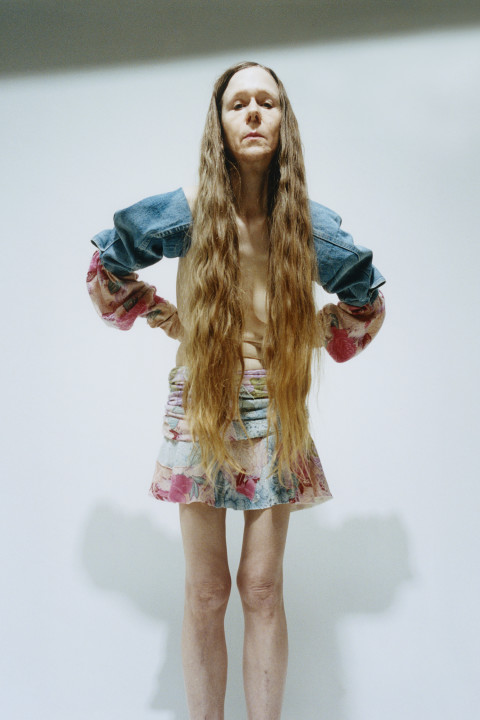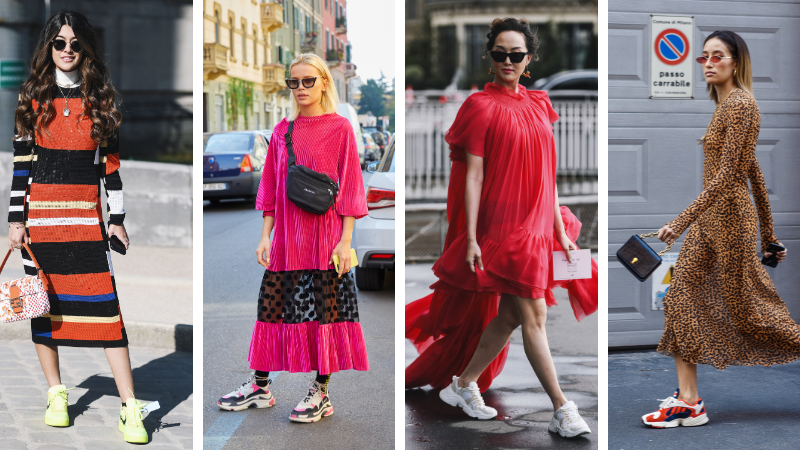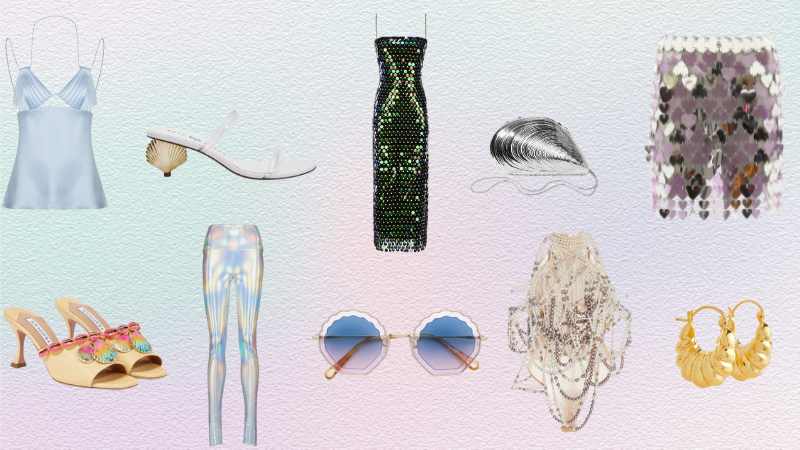Why Be Out When You Can Be ALL-IN
From vintage shops in Rome to Kylie Jenner’s feet, the magazine-turned-brand explains its philosophy in this exclusive interview.

There’s a small, eclectic vintage shopkeeper in Rome, who opens for business around 10 PM and closes at 4 AM. Since his early adolescence, Benjamin Barron has visited her shop, her spirit of repurposing serving as a fundamental source of inspiration for what would eventually become ALL-IN.
“Once I found a cotton bag, with sailor stripes, in the silhouette of a T-shirt; a zipper and simple string at the top. Everyone was like, ‘Oh my God, is that Bless? Margiela? Who made that?’ And then August found the exact same thing at a separate flea market in Oslo! Except with an IKEA tag inside.”Barron, then 22, who began ALL-IN as an editorial publication in 2015, met Bror August Vestbø, then 18 and originally from Oslo, at the magazine’s first launch. Barron worked mainly as a photographer at the time, while Vestbø was interning for several other brands. The two began collaborating on photo shoots, pulling garments from flea markets and charity shops for the purpose of styling them into characters. This often led to the framework for a new garment, which created a familiar yet unplaceable character—ultimately leading to both of them implementing a more dedicated focus to ALL-IN as designers.The T-shirt bag turned out to be just a cushion cover for a baby high chair. The shopkeeper in Rome had added the string at the top to look like a bag. “It’s very beautiful to see that you can find these things that are nothing and so easily turn them into something else,” says Barron. “Everyone wants this bag and it’s literally just part of a baby high chair.”

This unpretentiousness toward discarded or used materials and openness to possibility has served both Barron and Vestbø well in the fledgling years of ALL-IN. In the time that’s followed, it’s been a slow evolution and meditation on this formula, expanding to create footwear and collaborating with wholesalers. Their impressive skill and reverence for (rather than performance of) upcycling has afforded them a particular level of cachet in the industry. Maryam Nassir Zadeh asked if she could sell their one-off creations in her store, where they presented their first collection in 2019; for their SS22 presentation, Lotta Volkova walked the runway; and the most recent (and perhaps most polarizing) cover of features Kylie Jenner in the ALL-IN Prom miniskirt and the label’s revered Level boots, an almost official marker of the brand’s transition from cult favorite to mainstream. As the ALL-IN intrigue grows, and the label continues to blossom and evolve from one-off to mass-production, Barron and Vestbø share thoughts on fledgeling fashion woes, dreams for the future, as well as what and who inspires them (hint: she’s in these photos).

I’m curious about your experience as a brand that is still relatively young. How has it been to be “emerging” and reckoning with forces such as inflation and the at times inhospitable nature of fashion?I like that attitude.Do you find that upcycling helps to offset costs?
Bror August: Literally right before this I was trying to plan our budget and I’m just like, “How is this ever gonna add up?” It’s hard. We started by making one-of-a-kind pieces and not really selling or spending much money on our practice, but when you’re supposed to produce entire orders or make big payments… we didn’t really plan for it. We didn’t realize how these things work. We dabbled at first, “Oh sure we’ll sell it. Oh yeah we’ll do that,” and then it’s like oh— Benjamin Barron: Neither of us have a real business perspective towards the brand, so it’s been very much a learning process to encounter things as they come. We’ve had some luck with our Level boot, for instance. It did well commercially, considering we’re such a small brand. Just thinking about all of my favorite brands or designers, they don’t exist anymore. In an interview recently one of the questions was, “Are you afraid of becoming a has-been?” And I was like no, all my favorite designers are has-beens. BA: So we’re preparing to become one [laughs].BB: It’s daunting. You hear about it with other small brands too, I guess it just feels sometimes like the fashion industry isn’t really built to support young brands. There’s the same amount of pressure on an established conglomerate brand as there is on an independent brand. And often there’s even more pressure on the young brand because we don’t receive the same treatment from factories or from stores because we aren’t yet established. BA: You’re at the bottom of the system. BB: It’s definitely hard for an emerging brand to figure out how to navigate it without getting into debt, which happens to so many small labels. BA: No one has told me that it’s not true! Another thing I’ve been thinking about with fashion brands that are more “artistic” clothing—in the art world, the galleries work to maintain and increase the value of art. The fashion industry is almost the opposite—everyone is trying to break down the value constantly. BB: We were speaking with Miguel Adrover recently for the upcoming edition of ALL–IN about the way fashion is centered around making work “in the name of.” It feels like there isn’t going to be a space for young designers to emerge as long as we’re preserving the identities of designers that are deceased for the sake of big corporations. BA: Miguel was discussing how young talent gets moved to houses to make work in the name of someone famous who passed away, when no one would consider continuing to make work in the name of Pablo Picasso.BA: For us, no. Opposite. BB: With the one-of-a-kind pieces we make, it goes back to the point about value. There are very few people who can value a piece of clothing made from something found at a flea market at the cost that it actually takes us to make something. BA: It’s a lot of time. For us, at least. Maybe other brands have figured a better system out for theirs, but the way we work is very specific, like oh it’s pink Princess T-shirts. Or it’s like a pop star T-shirt, so you can’t find that super easily. Collecting and sourcing is a huge part of our process. It’s hard for people to understand that the reason something we make costs a lot is because we’ve spent days on this process. We work a lot with individual pieces, working on the combinations and the compositions so it becomes a one-of-a-kind edition. With other brands their approach is often that you create a pattern and work with whatever materials you receive. That’s not our approach so far.

With regard to your comment about how not everyone can appreciate something that has been made from a vintage or preexisting garment, why do you think that the idea of glamour or luxury is at odds with sustainable practices?But in a way that’s almost the most sustainable practice, seeing beauty or potential in those things and choosing them as the best vehicle to communicate a fashion idea.
BB: Based on other people’s feedback, it seems like it can be a cultural thing, or that people feel attached to “newness.” BA: I mean, also the fact that they were worn or stained—while that is a bit trendy of course in another way—you don’t actually want to stain your clothes. So when you buy something that is stained by someone else… BB: We also try not to work with pieces that we feel are too nice to be redesigned. We try to work with pieces that we feel have the capacity to turn into something better. We often like to work around imperfections—that’s the value that is hard for someone to see. It takes a specific customer. Our basis for the collection is redesign, but it’s become more of a method for designing than it is about needing to be the most ethical way to make clothing. And there’s something that we love about working with materials that have character embedded in them. Incorporating some of that into something that is then thrown off from what it was. But at the end of the day it’s hard when you realize that people can’t easily wear clothing that’s so unique. But we also would like people to be able to wear our clothing, so we now work with translating these pieces from our practice with redesign into garments that can be reproduced. I guess it’s nice that it’s a little bit sustainable what we do, but— BA: That’s not why we’re interested in using source material. It’s more icing on the cake.BA: I feel like one of the best outcomes possible could be that because you put the vintage thing that you found in a market into another context, now that thing also actually has a high fashion context. BB: And also that people can think about reinterpreting their own pieces of clothing. There’s something about the disposability of fashion that is alarming so I feel like it’s nice for people to believe they can constantly re-contextualize things.

Speaking of context, you recently spoke with Vogue about how teenagers are the archetypal symbol of indulging in aesthetics that you don’t have any understanding of. Do you think that is inherently teen? Or more characteristic of our current era? You can buy any identity you want essentially on Amazon.No Bra is a somewhat elusive performance artist and musician. How does she fit into this context?
BA: I think it is very unique to this generation. Because before, to know of a culture you had to be living in it. And now you can buy it or just see it online. Like P!NK for instance. I remember I was a big P!NK fan and I thought I was really rock and punk but actually I didn’t know anything about rock or punk. But I was mimicking that aesthetic through her interpretation of that aesthetic. Then I mixed that with all these other things that I was wrapped up in because you’re also exploring other identities at the same time. So the collection references this collaging of all of your favorite idols; they become an unplaceable character, which is a new identity in itself. That’s something that we’re working towards, creating garments that create a character. Something that’s familiar, but it’s never someone that’s completely placeable.BA: I mean she’s just really fab. BB: With our casting, we mostly work with people that we’re immediately drawn to. BA: She could be that type of person that can be this character we were talking about. BB: Yeah. I think so too. BA: We wanted to cast her for the last show and I think she was somewhere really remote that took like—it was in Europe, but it was 14 hours for her to get to Paris. And I love her music too. BB: We just really like her. She’s really cool [laughs]. I feel like she’s someone that inspires us, but it’s not an obvious connection.

How much of your time is spent on the publication side of things? Are there other ways you want to expand the ALL-IN world?
BB: We like to think of the project being translated into different contexts. A friend of ours who works with us on set design for the show at one point asked us to work on a collaboration for furniture. I think that could be really exciting. A perfume would be really fun to work on. I think there’s many different ways to explore what ALL-IN is. And I guess that’s also why the magazine is so fun: It’s purely visual. It’s just printed material, but last issue we got to make a vinyl record with Smerz, Isabella Lovestory, and Lolina—all musicians that we love.. It was a way for us to translate ALL-IN into sound as well. BA: The name of the project hints that it can kind of be all types of things. Even for each format—for clothing we like to use objects and things that aren’t clothes to make clothes. For the magazine, we like to create it in two formats that aren’t a magazine and constantly move in between those boundaries or limits of what the project is. Which of course makes it hard to sell. But I feel like it’s fun for us to explore different ways of interpreting… BB: Traditional structures. BA: It’s exciting for us at least. Ben, what do we stand for? BB: Oh my God. I don’t know. BA: Why would you wanna be all out when you can be ALL-IN? BB: Oh my God, no [laughs].



